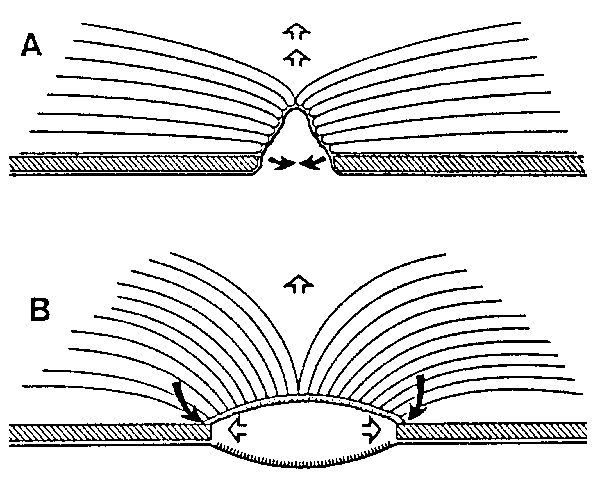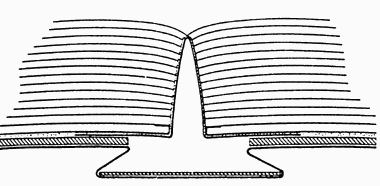 vspace="8" hspace="8" align="right">
vspace="8" hspace="8" align="right">
 vspace="8" hspace="8" align="right">
vspace="8" hspace="8" align="right">
The history of craft bookbinding technique shows that improvements have seldom been achieved without concomitant drawbacks. The introduction of the hollow back, instead of the earlier tight back, is one of the examples. Whereas the hollow or inlay was beneficial for the esthetic appearance of the spine, keeping the leather from creasing and damaging the gilt decoration, it became an additional source of strain at the joint region. When a book with tight back ("flexible spine") is opened, the spine will throw up and its outer edges will approach each other relatively freely (Fig. IA); with the hollow back, these movements are counteracted by the stiff inlay which constitutes an opposing mechanical force (Fig. 1B). The resulting strain is likely to cause damage to the hinge, starting with tears or partial detachment of the endleaves, and often ending with the detachment of the covers.

Figure 1. The opening of the tight back and hollow spine compared.
This problem has caused headaches for generations of bookbinders, as testified by the countless variants of endleave constructions. These were devised on empirical grounds-technical studies and scientific analysis of such problems have seldom been undertaken. A study of the causes of breakdown of library bindings, carried out in England in the early 50s, showed a clear correlation between spine thickness and joint breakdown. These results were the incentive for a new binding structure, devised by P.B.G. Upton of the PATRA (The Printing, Packaging and Allied Trades Research Association, a forerunner of PIRA) and patented by him in 1952 (Brit. Pat. 728,657). Instead of attempting another reinforcement of the endangered joint region, Upton's idea was to meet the anticipated detachment by leaving a portion of the endleaves (plus flanges of mull or lining) unattached to the boards. Simple considerations of the geometry indicated that the width of the free zone should equal one quarter of the spine thickness (hence: "quarter-joint"). This should allow a maximum throw-up of the spine and an unrestricted complete opening of the book, independently of its thickness, with leaves lying absolutely flat (Fig. 2, redrawn from Brit. Pat. 728,657, Fig. 1).

Figure 2. Upton's Quarter-joint Case.
I have tested the principle on several models, sewn on tape, lined with textile using either paste with hot glue or PVA adhesive, employing endleaves reinforced with a sufficiently wide strip of shirting. The covering of the spine is leather with an inlay of thin board; the boards (their width being shortened by the width of the free zone) are covered with a suitable material and separately glued to the textblock as the final step. There air no squares. The book has a flat spine; the sewing should not produce too much swelling, since a Founded spine will only lead to sagging of the fore-edge. The result is a remarkably flexible book, which opens fully and seems not to be harmed by the copying machine.
The aim of this note is to save Upton's contribution from oblivion, and to draw attention to the potential of the "quarter-joint" structure as a conservation binding. It seems eminently suited to ensure an unrestricted functioning of the book, which is the binding's primary task. It provides sufficient protection, and its outward appearance is devoid of any esthetic compromises, which in the past often interfered with optimal book function. Its virtue lies in the adhesive-free zone along the joint, which has been recognized as an advantage also by others. Gary Frost has drawn attention to the unfavorable effect of a too-tight connection of textblock and cover and advocated a setback of adhesive seam away from the folds for a better function of certain conservation bindings (The New Bookbinder, 2 [19821, pp. 64-67.
A word of caution should be added. However suitable it seems to be as a conservation binding, the "quarter-joint" structure should be duly tested as to the durability of construction and materials to be used, before being applied on large scale. This holds, of course, for any other proposal for a conservation binding. We may have reason to forgive the binders of past generations for their errors, but we must hold ourselves to a higher standard because we have ways of testing binding methods so as to avoid those that are likely to work damage in the future.